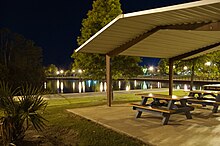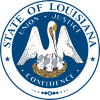Florida Parishes
Florida Parishes | |
|---|---|
 Downtown Baton Rouge, Louisiana | |
 Flag | |
 | |
| Country | United States |
| State | Louisiana |
| Population (2020) | |
| • Total | 1,088,014 |
The Florida Parishes (Spanish: Parroquias de Florida, French: Paroisses de Floride), on the east side of Mississippi River—an area also known as the Northshore or Northlake region—are eight parishes in southeast Louisiana, United States, which were part of West Florida in the 18th and early 19th centuries.[1] Unlike most of the state, this region was not part of the 1803 Louisiana Purchase;[2][3] it had been under British and then Spanish control since 1763.
History[]
The area that became the Florida Parishes was at one time part of French Louisiana. Following the French and Indian War, however, the region, like most of the rest of French Louisiana east of the Mississippi River (excluding New Orleans), was transferred to Great Britain. This region became part of the British colonial province of West Florida.[4]
Following the American Revolutionary War, West Florida was the subject of a border dispute between the newly formed United States and Spain, which acquired West and East Florida from the British after the war. The dispute led American and British settlers in the part of West Florida west of the Pearl River to declare an independent Republic of West Florida in 1810 and elected their leader,[5] Fulwar Skipwith, as president; none of the short-lived Republic of West Florida lay within the boundaries of the modern U.S. state of Florida.[citation needed]
The flag of the Republic of West Florida, which is often identified with the Bonnie Blue Flag of the Civil War era, flies on many public buildings in the Florida Parishes. In 2006, the state legislature designated it the "official flag of the Republic of West Florida Historic Region."[6]
The republic was quickly annexed by the United States,[5] and the present-day Florida Parishes were incorporated into the Territory of Orleans, which joined the Union as the U.S. state of Louisiana in 1812. In 1810, four parishes were established in the region: East Baton Rouge, Feliciana, St. Helena, and St. Tammany. Later in the 19th century, five additional parishes were created as follows, with Feliciana Parish ceasing to exist: Washington Parish, 1819, from part of St. Tammany Parish; East Feliciana and West Feliciana parishes, 1824, by dividing Feliciana Parish; Livingston Parish, 1832, from part of St. Helena Parish; and Tangipahoa Parish, 1869, from parts of Livingston, St. Helena, St. Tammany, and Washington parishes.[citation needed]
In 1990, Louisiana's legislature formally designated this part of the state as "the Republic of West Florida Historic Region, or the Florida Parishes."[7] Since 1993, Interstate 12, which runs east and west through the Northshore region, has been officially designated as the Republic of West Florida Parkway.[8]
Geography[]


The Florida Parishes of Louisiana stretch from the Mississippi state line on its eastern and northern borders to the Mississippi River on its western border, and Lake Pontchartrain on its southern border. The most populated community is the Baton Rouge metropolitan area. St. Tammany Parish is part of the New Orleans metropolitan area. The parishes have a land area of 4,685.184 square miles (12,134.57 km2), or 10.755% of the state's total land area.
Parishes[]
- East Baton Rouge Parish
- East Feliciana Parish
- Livingston Parish
- St. Helena Parish
- St. Tammany Parish
- Tangipahoa Parish
- Washington Parish
- West Feliciana Parish
Climate[]
The Florida Parishes (in common with Greater New Orleans and Acadiana) has a humid subtropical climate, prone to hurricanes. All of the Florida Parishes and parts of Acadiana flooded during the 2016 floods.[9][10] During Hurricane Katrina, both regions were used as evacuation areas for residents of Greater New Orleans.[11][12]
Demographics[]
The population of the Florida Parishes at the 2010 census was 1,019,357 residents, or 22.49% of the state's population at that time.[13] Its largest communities are, in descending order of population (2010 U.S. census), Baton Rouge, Slidell, Central, Hammond, Shenandoah (CDP), Zachary, Baker, Bogalusa, Mandeville, Gardere (CDP), Merrydale (CDP), Denham Springs, Covington, Lacombe (CDP), and Oak Hills Place (CDP). Tabulating the 2019 census estimates, the Florida Parishes had a population of 1,067,634, making it the third largest region by population following Acadiana (1,490,449) and Greater New Orleans (1,507,017); in 2020, the tabulated population of the Florida Parishes was 1,088,014.
Race and ethnicity[]
The region is divided into nine planning commissions. In the first planning commission,[14] 54% of the population was White American, 43% Black or African American, 1% multiracial, and 2% Hispanic or Latin American of any race at the 2019 census estimates program. The second commission's racial and ethnic makeup was 60% White, 25% Black or African American, 5% Asian, 3% multiracial, and 6% Hispanic or Latino of any race.[15] In the third commission, 41% were White American, 49% Black or African American, 3% Asian, 1% two or more races, and 4% Hispanic or Latin American.[16] Approximately 34% of the population was White, 62% Black or African American, 1% Asian, 1% multiracial, and 2% Hispanic or Latino in the fourth commission.[17] The fifth commission had 68% White Americans, 22% Blacks and African Americans, 1% Asians, 3% multiracials, and 6% Hispanic or Latino residents in the area.[18] An estimated 85% of the sixth commission were White, followed by 9% Black or African American, 1% Asian, 2% two or more race, and 4% Hispanic and Latin American residents.[19] The seventh area was 64% White, 30% Black or African American, 1% Asian, 2% multiracial, and 4% Hispanic or Latino;[20] the eighth commission's residents were 86% White, 6% Black or African American, 1% Asian, 1% multiracial, and 5% Hispanic or Latin American.[21] In the ninth commission, 70% were White, 19% Black or African American, 1% Native American or Alaska Native, 2% Asian, 2% multiracial, and 6% Hispanic or Latino.[22]
Religion[]
While Greater New Orleans and Acadiana are predominately Catholic, the Florida Parishes are greatly influenced by Protestantism. In contrast with North and Central Louisiana, the Florida Parishes region is still dominated by the Catholic Church as the single largest Christian denomination. The second largest overall denominational tradition in the region (especially Greater Baton Rouge)[23] are Baptists, divided among the Southern Baptist and National Baptist conventions (USA and America).
See also[]
- Intrastate regions
- Republic of West Florida
- Lake Pontchartrain
References[]
- ^ "Florida Parishes". National Park Service. Retrieved 2021-06-07.
- ^ "Florida Parishes". Southeastern University. Retrieved 2021-06-07.
- ^ "Florida Parishes in the Civil War". 64 Parishes. Retrieved 2021-06-07.
- ^ "History of West Florida". University of Chicago. Retrieved 2021-06-07.
- ^ a b "The History of the Short-Lived Independent Republic of Florida". Smithsonian Magazine. Retrieved 2021-06-07.
- ^ "2006 Louisiana Laws – RS 25:705 — Bonnie blue flag adopted". Justia US Law. Retrieved 2 Aug 2012.
- ^ "LA Rev Stat § 25:701 Republic of West Florida Historic Region". Justia US Law. Retrieved 2 Aug 2012.
- ^ "200th anniversary of the Republic of West Florida marked in St. Tammany". NOLA.com. Retrieved 2021-06-07.
- ^ "Louisiana flood: Worst US disaster since Hurricane Sandy, Red Cross says". CNN. 2016-08-18. Retrieved 2021-06-07.
- ^ "August 2016 extreme rain and floods along the Gulf Coast". NOAA. Retrieved 2021-06-07.
- ^ "Baton Rouge grew after Katrina while forging closer ties to recovering New Orleans". The Advocate. Retrieved 2021-06-07.
- ^ "RISK COMMUNICATION AND PUBLIC RESPONSE DURING EVACUATIONS: The New Orleans Experience of Hurricane Katrina". Public Performance & Management Review. 32 (3): 437–462. 2009. ISSN 1530-9576.
- ^ "U.S. Census website". United States Census Bureau. Retrieved 2020-10-09.
- ^ "Census profile: Capital Region Planning Commission 1--Baton Rouge Metropolitan Area (West) PUMA, LA". Census Reporter. Retrieved 2021-06-07.
- ^ "Census profile: Capital Region Planning Commission 2--East Baton Rouge Parish (South) PUMA, LA". Census Reporter. Retrieved 2021-06-07.
- ^ "Census profile: Capital Region Planning Commission 3--Baton Rouge City PUMA, LA". Census Reporter. Retrieved 2021-06-07.
- ^ "Census profile: Capital Region Planning Commission 4--East Baton Rouge Parish (North) PUMA, LA". Census Reporter. Retrieved 2021-06-07.
- ^ "Census profile: Capital Region Planning Commission 5--Ascension Parish PUMA, LA". Census Reporter. Retrieved 2021-06-07.
- ^ "Census profile: Capital Region Planning Commission 6--Livingston & St. Helena Parishes PUMA, LA". Census Reporter. Retrieved 2021-06-07.
- ^ "Census profile: Capital Region Planning Commission 7--Tangipahoa & Washington Parishes PUMA, LA". Census Reporter. Retrieved 2021-06-07.
- ^ "Census profile: Regional Planning Commission 1--St. Tammany Parish (Northwest) PUMA, LA". Census Reporter. Retrieved 2021-06-07.
- ^ "Census profile: Regional Planning Commission 2--St. Tammany Parish (Southeast) PUMA, LA". Census Reporter. Retrieved 2021-06-07.
- ^ "Religion in Baton Rouge, Louisiana". Sperling's BestPlaces.
External links[]
- Historical regions
- Regions of Louisiana
- Louisiana parishes
- Spanish Florida
- West Florida
- Former regions and territories of the United States
- Territory of Orleans
